湘少版六年级英语上册
- 格式:doc
- 大小:28.50 KB
- 文档页数:3
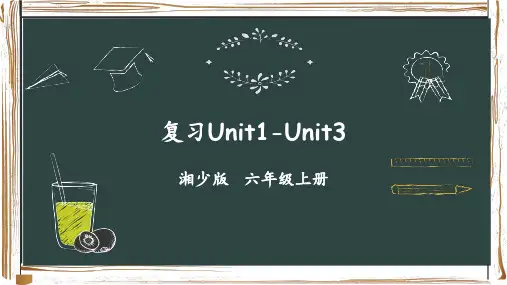
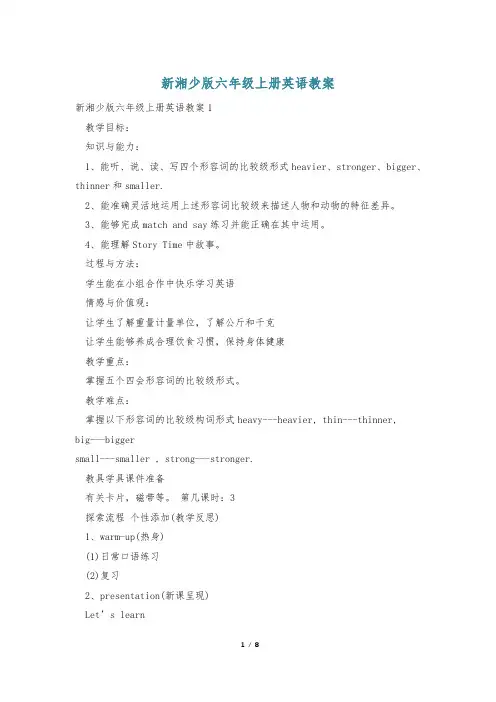
新湘少版六年级上册英语教案新湘少版六年级上册英语教案1教学目标:知识与能力:1、能听、说、读、写四个形容词的比较级形式heavier、stronger、bigger、thinner和smaller.2、能准确灵活地运用上述形容词比较级来描述人物和动物的特征差异。
3、能够完成match and say练习并能正确在其中运用。
4、能理解Story Time中故事。
过程与方法:学生能在小组合作中快乐学习英语情感与价值观:让学生了解重量计量单位,了解公斤和千克让学生能够养成合理饮食习惯,保持身体健康教学重点:掌握五个四会形容词的比较级形式。
教学难点:掌握以下形容词的比较级构词形式heavy---heavier, thin---thinner,big---biggersmall---smaller , strong---stronger.教具学具课件准备有关卡片,磁带等。
第几课时:3探索流程个性添加(教学反思)1、warm-up(热身)(1)日常口语练习(2)复习2、presentation(新课呈现)Let’s learn(1)教师拿出一双大人鞋子一双小孩的鞋子作比较,让一呈现单词bigger和smaller。
(板书bigger和smaller)让学生观察bigger不同。
(2)教师用PPT展示两张胖瘦人照片教授单词thinner和heavier(板书thinner和heavier),让学生观察heavier的不同。
(3)、出示健美教练的照片进而新授单词stronger。
(板书stronger)(4)、教师出示这几个单词卡,让学生比较它们的不同,词卡上又不颜色的笔书写比较级的变化。
(5)、放录音跟读单词。
(6)、学生和自己的同伴自己练习,根据他们的实际情况,并让特征明显的同学上台表演。
看谁做的又快又好。
practice(练习)Match and say教师先示范和一名同学,鼓励学生说出又创意的句子,如:Mike’s fish is bigger than mine.S1:sarah’s fish is(2)story time学生默读后回答,“Who is an excellent goalkeeper?” Why?让学生说出不理解的句子,一块讨论,扫清阅读障碍。

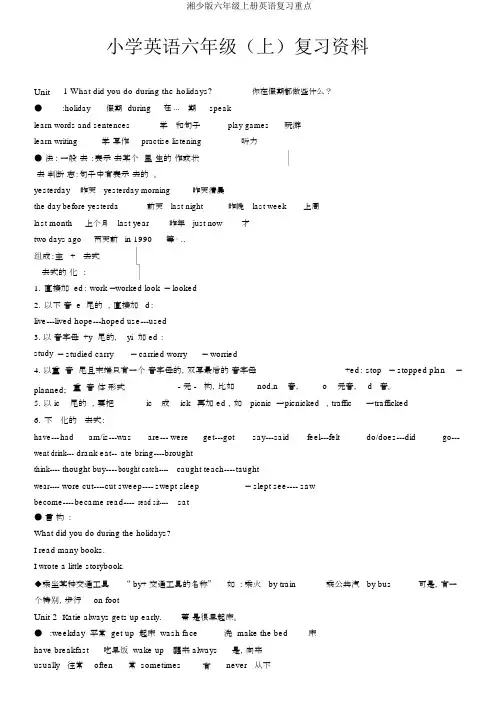
小学英语六年级(上)复习资料Unit 1 What did you do during the holidays?你在假期都做些什么?● :holiday假期during在 ...期speaklearn words and sentences学和句子play games玩游learn writing学写作practise listening听力● 法 : 一般去:表示去某个里生的作或状去判断志:句子中有表示去的。
yesterday昨天yesterday morning昨天清晨the day before yesterda前天last night昨晚last week上周last month上个月last year昨年just now才two days ago两天前in 1990等⋯ ..组成:主 +去式去式的化:1.直接加 ed: work —worked look — looked2.以不音 e 尾的,直接加 d:live---lived hope---hoped use---used3.以音字母 +y 尾的, yi 加 ed :study— studied carry— carried worry— worried4. 以重音尾且末端只有一个音字母的,双写最后的音字母+ed: stop— stopped plan—planned;5. 以 ic重音体形式尾的,要把ic成- 元 - 构,比如ick再加ed,如nod,n 音,picnic →picnickedo元音,,trafficd 音。
→trafficked6.不化的去式:have---had am/is---w as are---were get---got say---said feel---felt do/does---did go---went drink---drank eat--ate bring----broughtthink----thought buy----bought catch----caught teach----taughtwear----wore cut----cut sweep----swept sleep— slept see----sawbecome----became read----read sit----sat● 言构 :What did you do during the holidays?I read many books.I wrote a little storybook.◆乘坐某种交通工具“ by+ 交通工具的名称”如 : 乘火 by train乘公共汽 by bus可是,有一个特别,步行on footUnit 2 Katie always gets up early.蒂是很早起床。

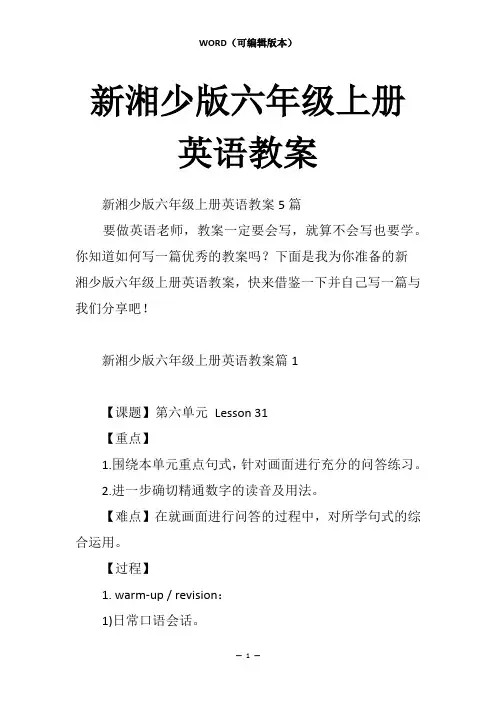
新湘少版六年级上册英语教案新湘少版六年级上册英语教案5篇要做英语老师,教案一定要会写,就算不会写也要学。
你知道如何写一篇优秀的教案吗?下面是我为你准备的新湘少版六年级上册英语教案,快来借鉴一下并自己写一篇与我们分享吧!新湘少版六年级上册英语教案篇1【课题】第六单元Lesson 31【重点】1.围绕本单元重点句式,针对画面进行充分的问答练习。
2.进一步确切精通数字的读音及用法。
【难点】在就画面进行问答的过程中,对所学句式的综合运用。
【过程】1. warm-up / revision:1)日常口语会话。
2)游戏:猜猜数字:一个学生心里想一个数字,其他学生猜测:学生问:Is it …?这个同学根据别的同学的猜测进行判断,并用UP / DOWN 来提示。
看谁能够最先猜出这个数字。
在学生游戏过程中,教师要注意引导,纠正学生不正确的发音。
3)读一读:教师出示单词卡片,学生齐读或个人读单词,教师纠正发音。
教师注意倾听学生-teen和-ty 的读音。
4)听一听:教师口述,学生写出听到的数字。
2. Learn to say:1)学生打开书看一分钟,注意观察画面。
2)合上书,回忆你在画面上看到了什么?What did you see in the picture? 锻炼学生记忆力。
3)四个人为一个小组,相互交流曾看到了什么。
Please talk about what you see in the pictures in you groups.4)学生叙述看到的.东西,教师播放与课文配套的影片。
教师根据学生叙述的进程,点击画面,出现一些实物场景或图片。
教师引导学生回答:How many … are there in the picture?Where are they?教师提问:What colour is it / are they?回答后,再播放一遍影片。
5)教师此时可以面向学习上有困难的学生提问,引导他们复习提问的方法。
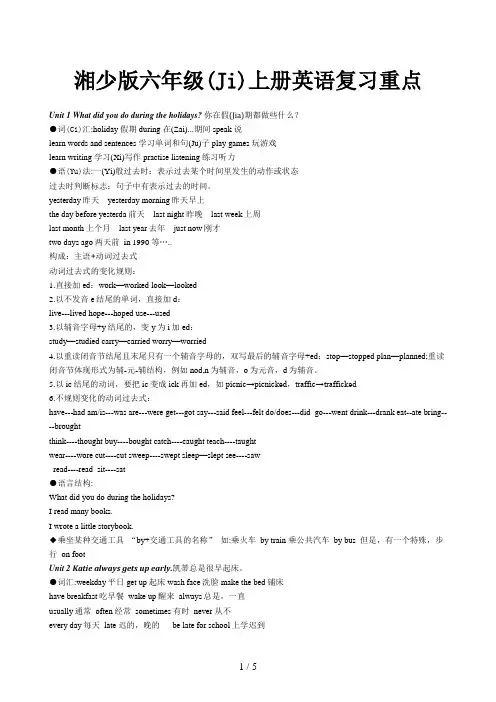
湘少版六年级(Ji)上册英语复习重点Unit 1 What did you do during the holidays? 你在假(Jia)期都做些什么?●词(Ci)汇:holiday 假期 during 在(Zai)...期间 speak 说learn words and sentences 学习单词和句(Ju)子 play games 玩游戏learn writing 学习(Xi)写作 practise listening 练习听力●语(Yu)法:一(Yi)般过去时:表示过去某个时间里发生的动作或状态过去时判断标志:句子中有表示过去的时间。
yesterday昨天yesterday morning昨天早上the day before yesterda前天last night 昨晚last week上周last month上个月last year去年just now刚才two days ago两天前in 1990 等…..构成:主语+动词过去式动词过去式的变化规则:1.直接加ed:work—worked look—looked2.以不发音e结尾的单词,直接加d:live---lived hope---hoped use---used3.以辅音字母+y结尾的,变y为i加ed:study—studied carry—carried worry—worried4.以重读闭音节结尾且末尾只有一个辅音字母的,双写最后的辅音字母+ed:stop—stopped plan—planned;重读闭音节体现形式为辅-元-辅结构,例如nod,n为辅音,o为元音,d为辅音。
5.以ic结尾的动词,要把ic变成ick再加ed,如picnic→picnicked,traffic→trafficked6.不规则变化的动词过去式:have---had am/is---was are---were get---got say---said feel---felt do/does---did go---went drink---drank eat--ate bring----broughtthink----thought buy----bought catch----caught teach----taughtwear----wore cut----cut sweep----swept sleep—slept see----sawread----read sit----sat●语言结构:What did you do during the holidays?I read many books.I wrote a little storybook.◆乘坐某种交通工具“by+交通工具的名称” 如:乘火车by train 乘公共汽车by bus 但是,有一个特殊,步行on footUnit 2 Katie always gets up early.凯蒂总是很早起床。
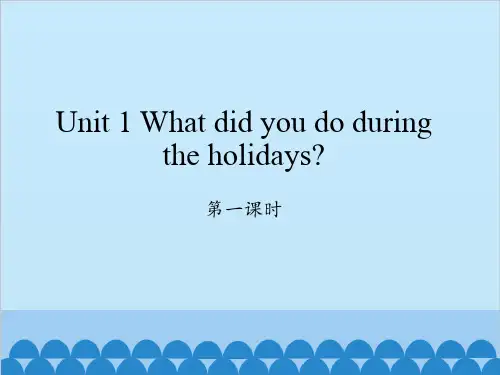
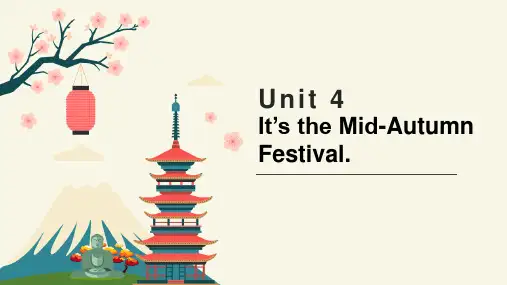
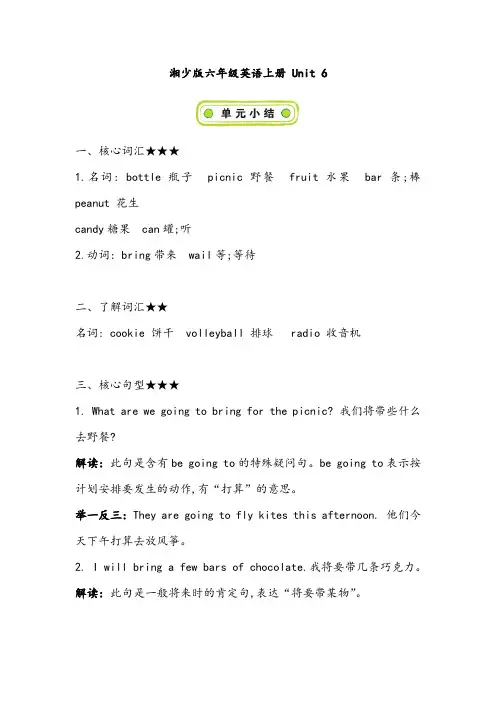
湘少版六年级英语上册 Unit 6
一、核心词汇★★★
1.名词: bottle瓶子 picnic野餐 fruit水果 bar条;棒peanut 花生
candy糖果 can罐;听
2.动词: bring带来 wail等;等待
二、了解词汇★★
名词: cookie 饼干 volleyball 排球 radio 收音机
三、核心句型★★★
1. What are we going to bring for the picnic? 我们将带些什么去野餐?
解读: 此句是含有be going to的特殊疑问句。
be going to表示按计划安排要发生的动作,有“打算”的意思。
举一反三: They are going to fly kites this afternoon. 他们今天下午打算去放风筝。
2. I will bring a few bars of chocolate.我将要带几条巧克力。
解读: 此句是一般将来时的肯定句,表达“将要带某物”。
四、了解句型★★
The weather is getting cool and nice.天气变得凉爽清新。
解读: 此句是用现在进行时来表示动作的逐渐变化。
表示渐变的动词有: get、grow、become、turn等。
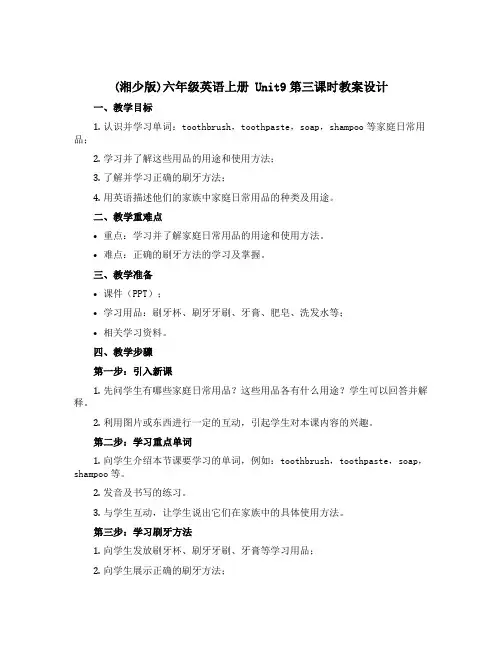
(湘少版)六年级英语上册 Unit9第三课时教案设计一、教学目标1.认识并学习单词:toothbrush,toothpaste,soap,shampoo等家庭日常用品;2.学习并了解这些用品的用途和使用方法;3.了解并学习正确的刷牙方法;4.用英语描述他们的家族中家庭日常用品的种类及用途。
二、教学重难点•重点:学习并了解家庭日常用品的用途和使用方法。
•难点:正确的刷牙方法的学习及掌握。
三、教学准备•课件(PPT);•学习用品:刷牙杯、刷牙牙刷、牙膏、肥皂、洗发水等;•相关学习资料。
四、教学步骤第一步:引入新课1.先问学生有哪些家庭日常用品?这些用品各有什么用途?学生可以回答并解释。
2.利用图片或东西进行一定的互动,引起学生对本课内容的兴趣。
第二步:学习重点单词1.向学生介绍本节课要学习的单词,例如:toothbrush,toothpaste,soap,shampoo等。
2.发音及书写的练习。
3.与学生互动,让学生说出它们在家族中的具体使用方法。
第三步:学习刷牙方法1.向学生发放刷牙杯、刷牙牙刷、牙膏等学习用品;2.向学生展示正确的刷牙方法;3.让学生跟随老师的示范进行刷牙;4.分别检查每位学生的刷牙姿势是否正确。
第四步:语言材料1.随堂播放一段短片或图片,介绍家庭日常用品的种类及它们的用途;2.让学生在小组内讨论家族中用的日常用品的种类及用途,并在小组内演示一下。
第五步:巩固练习1.播放短片或图片,让学生找出其中的家庭日常用品,并说出它的名称及用途;2.分组进行擂台比赛,比较自己家族中的日常家居用品种类,设身处地从自己的立场出发,对自己的家居用品进行详细描述。
第六步:总结1.回顾刷牙方法及家庭日常用品的学习;2.问答环节,检查学生的学习效果。
五、课后作业1.将家族中的家庭日常用品拍照,并用英语描述其名称及用途;2.根据老师的指导,写一篇60-80单词的短文,介绍自己家中常用的日常用品,其中一定应有牙刷、牙膏等刷牙用品。
湘少版六年级上册英语语法HEN system office room 【HEN16H-HENS2AHENS8Q8-HENH1688】背诵下面语法知识一、名词单数变复数的变化规则:1.一般情况直接加s2.以s,x, sh, ch结尾的加 es3.以o结尾的,表示“有生命”的事物加espotato-------potatoes 土豆 tomato------tomatoes 西红柿4.以o结尾的,表示“无生命”的事物加szoo------zoos 动物园 photo------photos 照片5.以辅音字母+y结尾的,先变y为i再加es;6..以f或fe结尾的名词,把f或fe变为v再加es.7.特殊变化的复数:man------men 男人 woman------women 女人child------children 孩子(们) mouse------mice 老鼠foot-------feet 脚 tooth------teeth 牙齿二、现在分词(动词ing)的变化规则1、一般情况下直接加ing,2、以一个不发音的e结尾的,先去e再加ing,take-----taking 拍(照), make-----making 制造,制作3、重读闭音节词,先双写最后一个字母再加ing,run------running 跑, swim------swimming, 游泳skip-----skipping 跳绳三、动词的第三人称单数的变化规则1、一般情况直接加s,2、以s, sh, ch, o 等字母结尾的加es,wash------washes 洗 go------goes 去3、以辅音字母加y结尾的,先把y改为i,再加es,4、特殊变化:have-----has 有,吃四、动词的过去式1.一般情况直接加ed,2.以不发音e结尾的只加d,3.以辅音字母加y结尾的,变y为i再加ed,4.重读闭音节词,先双写最后一个辅音字母,再加ed,5.特殊变化go---went is---was are---were have---hadtake---took eat---ate read---read cut---cutput---put do---did come---came feel----feltlearn---learnt speak---spoke teach---taught say---said run---ran swim---swam stand---stood sing--- sangwrite---wrote can---could see---saw bring---brought五、形容词比较级和最高级的变化规则1. 一般情况下在词尾加er或est;2. 以不发音字母e结尾的,只加r 或st;3. 重读闭音节词,先双写最后一个字母,再加er或est;4. 以辅音字母+y结尾的,先把y改为i,再加er 或est;5.多音节和部分双音节形容词,在这个词前加more表示比较级,在这个词前加most表示最高级。
可编辑修改精选全文完整版湘少版英语六年级上册重点知识表Unit 1 What did you do during the holidays ?你在假期里做了什么?单词:during 在……期间 holiday 假日;假期 learn 学习practise 练习 speak 说短语:learn words and sentences 学习单词和句子play games 玩游戏 during the holidays 在假期里learn writing 学习写作 write a storybook 写一本故事书practise listening 练习听力 stand up 起立句型:——What did you do during the holidays?你在假期里做了什么? ——I read many books.我读了很多书。
I visited my grandparents.我去看望了我的爷爷奶奶。
I played games with my friends.我和朋友们一起玩了游戏。
补充:动词的过去式:talk-talked 谈论 practise-practised 练习 listen-listened 听 climb-climbed 爬 do-did 做 have-had 有 go-went 去learn-learnt 学习 take-took 拿 read-read 读 speak-spoke 说teach-taught 教 write-wrote 写 run-ran 跑Unit2 Katie always gets up early.凯蒂总是很早起床。
单词:always 总是 weekday 平日 often 常常;时常 after 在……之后 wave 挥手 return 返回 sometimes 有时 never 从不 短语:wave goodbye 挥手再见 take photos 拍照be late for school 上学迟到 draw pictures 画画do my/her/his homework 做作业 have breakfast 吃早餐read a newspaper 读报纸 after/before dinner 吃晚餐后/前 play chess 下棋 return home 回家take a walk 散步 help my parents 帮助父母 句型:Peter always get s up at 7:00 a.m.皮特总是早上七点起床。
全新湘少版六年级英语上册知识归纳(全册)Unit1★动词过去式变化规律:1.一般情况下,直接在动词词尾加ed.如:talk—talked说listen—listened听play—played玩climb—climbed爬2.以不发音的e结尾,在动词词尾加d.如:practise—practised练习3.以辅音字母加y结尾的动词,变y为i再加ed.如:study—studied学习,研究4.以一个辅音字母结尾的重读闭音节词,双写最后一个辅音字母,再加ed.如:stop—stopped停止5.不规则动词没有规律,需要特殊记。
如:do-did have—had go—went learn—learnt take—took read—read speak—spoke teach—taught stand—stood sit—sat say—said run—ranis,am—was are—were write--wrote★单词、短语during在…期间holiday假期learn words and sentences学习单词和句子play games玩游戏learn writing学习写作practice listening练习听力★句子时态:一般过去时,表示过去某个时间里发生的动作或存在的状态。
主要有动词的过去式来体现,其标志词是过去的时间。
如:yesterday昨天last night昨晚last week上周last year 去年等等。
1.What did you do during the holidays?假期间你做了什么?--I read many books./I learnt writing./I wrote a little storybook in English./I visited my grandparents.Unit2★单词、短语weekday工作日after在…之后before在..之前always总是,经常often时常sometimes有时never从不wave goodbye挥手再见be late for school上学迟到read a newspaper读报纸play chess下棋take a walk散步get up起床have/has breakfast吃早餐return home回家★句子时态:一般现在时:表示经常,反复发生的动作或存在的状态。
湘少版六年级英语上册
Unit 5 It will be sunny and cool tomorrow.
(片段一)
一、Teaching contents:
Unit 5
二、Teaching Aims:
1、Enable the students to understand: read and say the words:
weather forecast, sunny and warm, sunny and cool, strong wind, light snow, light rain
2、Enable students to have a habit to know the weather before going outside.
三、Teaching difficulties:
master the new words and phrases
四、Teaching aids:
cards, PPT, video
五、Teaching methods:
The communicative approach
六、Teaching steps:
Step1 Greetings
T: Good morning, boys and girls. How are you today?
Ss: I’m fine, thank you.
T: Let’s review some words about weather. Now listen and guess.
S: sunny, rainy, windy, cloudy
Step 2 Presence
1、T: Today we’re going to learn Unit 5. It will be sunny and cool tomorrow.
2、phrases learning
light rain heavy rain
light snow heavy snow
light wind strong wind
sunny and warm sunny and cool
T: Look at the picture: What’s the weather like?
Ss: It’s rainy.
T: It’s a light rain.
The same way to teach other phrases.
T: Can you find some rules about these phrases?
Pay attention to the words: heavy and strong
T: Now, please listen and answer the question:
What does the man talk about? (Learn : weather forecast )
Step 3 Practice
Let's say it.
Look at the blackboard and speak out the words.
Blackboards design
Unit 5 It will be sunny and cool tomorrow
weather forecast
sunny and warm. a light rain/ a heavy rain.
a light snow/ a heavy snow.
sunny and cool. a light wind/ a strong wind.。